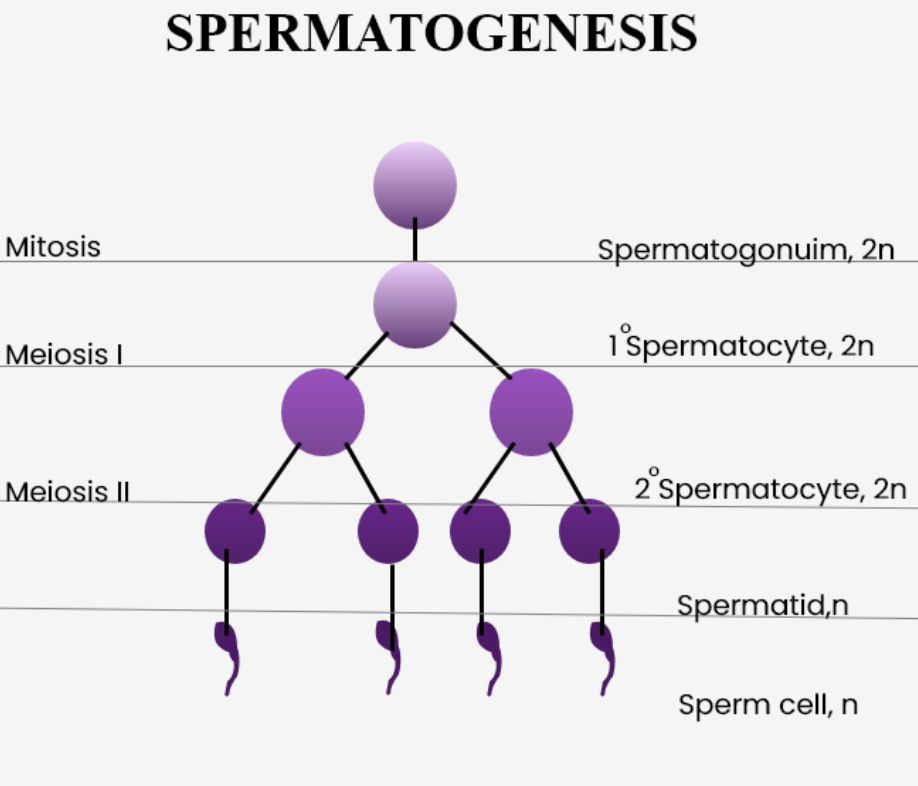Answer
405.3k+ views
Hint: Sperm formation is also known as spermatogenesis in which sperms are made from spermatogonia which are present in the lining of the walls of the testis. Ascaris is a genus that belongs to roundworms and some of its species cause diseases in humans as well.
Complete Answer:
The process of spermatogenesis is as follows:
- Male germs cells or the spermatogonia cells divide in number by mitosis to form primary spermatocytes.

- These primary spermatocytes are made into secondary spermatocytes by meiosis-I which in turn undergo meiosis-II to form spermatids.
- Spermatids undergo further development to form the spermatozoa or sperms.
- This process was first observed by Brauer in Ascaris.
Additional information: Let us look at the other scientists mentioned in the options.
- Alexander Fleming was a Scottish physician who discovered penicillin, the first antibiotic from Penicillium notatum.
- Theodor Boveri proposed the chromosomal theory of inheritance along with Sutton. He also discovered centrioles of centrosomes in Ascaris.
- Hugo de Vries was a Dutch botanist who worked on the inheritance pattern in evening primrose and proposed that mutations are responsible for variation in a population.
- Lemaitre Abbe was a priest who proposed the theory of the expanding universe.
So, the correct option is ‘(c) Brauer’.
Note:
- Aschelminthes are known as roundworms because they appear round when a cross- section of their body is viewed.
- Aschelminthes are triploblastic, pseudocoelomate, and bilaterally symmetrical animals.
- Ascaris lumbricoides cause ascariasis in humans which is an infection of the intestines.
- Another roundworm which is known as the filarial worm (Wuchereria) causes elephantiasis in humans by affecting the lymphatic vessels of the lower limbs.
Complete Answer:
The process of spermatogenesis is as follows:
- Male germs cells or the spermatogonia cells divide in number by mitosis to form primary spermatocytes.

- These primary spermatocytes are made into secondary spermatocytes by meiosis-I which in turn undergo meiosis-II to form spermatids.
- Spermatids undergo further development to form the spermatozoa or sperms.
- This process was first observed by Brauer in Ascaris.
Additional information: Let us look at the other scientists mentioned in the options.
- Alexander Fleming was a Scottish physician who discovered penicillin, the first antibiotic from Penicillium notatum.
- Theodor Boveri proposed the chromosomal theory of inheritance along with Sutton. He also discovered centrioles of centrosomes in Ascaris.
- Hugo de Vries was a Dutch botanist who worked on the inheritance pattern in evening primrose and proposed that mutations are responsible for variation in a population.
- Lemaitre Abbe was a priest who proposed the theory of the expanding universe.
So, the correct option is ‘(c) Brauer’.
Note:
- Aschelminthes are known as roundworms because they appear round when a cross- section of their body is viewed.
- Aschelminthes are triploblastic, pseudocoelomate, and bilaterally symmetrical animals.
- Ascaris lumbricoides cause ascariasis in humans which is an infection of the intestines.
- Another roundworm which is known as the filarial worm (Wuchereria) causes elephantiasis in humans by affecting the lymphatic vessels of the lower limbs.
Recently Updated Pages
How many sigma and pi bonds are present in HCequiv class 11 chemistry CBSE

Why Are Noble Gases NonReactive class 11 chemistry CBSE

Let X and Y be the sets of all positive divisors of class 11 maths CBSE

Let x and y be 2 real numbers which satisfy the equations class 11 maths CBSE

Let x 4log 2sqrt 9k 1 + 7 and y dfrac132log 2sqrt5 class 11 maths CBSE

Let x22ax+b20 and x22bx+a20 be two equations Then the class 11 maths CBSE

Trending doubts
Fill the blanks with the suitable prepositions 1 The class 9 english CBSE

At which age domestication of animals started A Neolithic class 11 social science CBSE

Which are the Top 10 Largest Countries of the World?

Give 10 examples for herbs , shrubs , climbers , creepers

Difference between Prokaryotic cell and Eukaryotic class 11 biology CBSE

Difference Between Plant Cell and Animal Cell

Write a letter to the principal requesting him to grant class 10 english CBSE

Change the following sentences into negative and interrogative class 10 english CBSE

Fill in the blanks A 1 lakh ten thousand B 1 million class 9 maths CBSE



